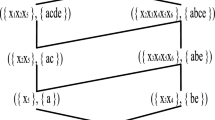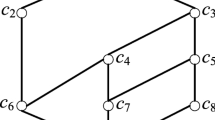Abstract
In traditional formal concept analysis, the attributes in the formal context are considered fixed. However, in the real world data set, attributes always have different levels of granularity, correspondingly, the derived concept lattice may reveal different information and patterns. Therefore, the capability to change the level of granularity of an attribute in formal concept analysis to capture relevant patterns in data is a natural requirement. In this paper, a theoretical study has been undertaken in multi-scale formal contexts, where attributes with different levels of granularity possess different attribute values. Two types of formal concepts, i.e., object-oriented and property-oriented multi-scale concepts, are introduced and studied in detail. The collection of object-oriented concept lattices and property-oriented concept lattices can be obtained at different granularity levels of attributes. It has been shown that the set of extents in the derived concept lattices increases when we choose to use a finer level of granularity. Moreover, a corresponding bidirectional approach to concept construction(i.e., from coarser to finer and from finer to coarser, respectively) is exhibited, and some characterization theorems have been obtained.
Similar content being viewed by others
References
Bargiela A, Pedrycz W (2016) Granular computing. In: Angelov PP (ed) Handbook on computational intelligence. Fuzzy logic, systems, artificial neural networks, and learning systems, vol 1. Kluwer Academic Publishers, Boston, pp 43–66
Bělohlavek R, De Baets B, Konecny J (2014) Granularity of attributes in formal concept analysis. Inf Sci 260:149–170
Chen YL, Wu YY, Chang RI (2012) From data to global generalized knowledge. Decis Support Syst 52(2):295–307
Düntsch I, Gediga G (2002) Modal-style operators in qualitative data analysis. In: Proceedings of the 2002 IEEE international conference on data mining, pp 155-162
Fan B, Tsang ECC, Xu W et al (2019) Attribute-oriented cognitive concept learning strategy: a multi-level method. Int J Mach Learn Cybern. https://doi.org/10.1007/s13042-018-0879-5
Ganter B, Wille R (1999) Formal concept analysis. Mathematical foundations. Springer, Berlin
Ganter B (1999) Attribute exploration with background knowledge. Theor Comput Sci 217(2):215–233
Gong F, Shao MW, Qiu G (2017) Concept granular computing systems and their approximation operators. Int J Mach Learn Cybern 8(2):627–640
Hao C, Li J, Fan M et al (2017) Optimal scale selection in dynamic multi-scale decision tables based on sequential three-way decisions. Inf Sci 415:213–232
He X, Wei L, She Y (2018) \(L\)-fuzzy concept analysis for three-way decisions: basic definitions and fuzzy inference mechanisms. Int J Mach Learn Cybern 9(11):1857–1867
Kumar CA, Srinivas S (2010) Concept lattice reduction using fuzzy K-means clustering. Expert Syst Appl 37(3):2696–2704
Kumar CA (2012) Fuzzy clustering-based formal concept analysis for association rules mining. Appl Artif Intell 26(3):274–301
Kang X, Li D, Wang S et al (2012) Formal concept analysis based on fuzzy granularity base for different granulations. Fuzzy Set Syst 203:33–48
Kang X, Miao D (2016) A study on information granularity in formal concept analysis based on concept-bases. Knowl Based Syst 105:147–159
Li J, Wu W, Deng S (2019) Multi-scale theory in formal concept analysis. J Shandong Univ (Nat Sci) 54(2):30–40 (in Chinsese)
Li J, Ren Y, Mei C et al (2016) A comparative study of multigranulation rough sets and concept lattices via rule acquisition. Knowl Based Syst 91:152–164
Li F, Hu B (2017) A new approach of optimal scale selection to multi-scale decision tables. Inf Sci 381:193–208
Li F, Hu B, Wang J (2017) Stepwise optimal scale selection for multi-scale decision tables via attribute significance. Knowl Based Syst 129:4–16
Li L (2017) Multi-level interval-valued fuzzy concept lattices and their attribute reduction. Int J Mach Learn Cybern 8(1):45–56
Liu Z, Li B, Pei Z, et al. (2017) Formal concept analysis via multi-granulation attributes. In: 12th International conference on intelligent systems and knowledge engineering (ISKE) IEEE, pp 1–6
Ma JM, Leung Y, Zhang WX (2014) Attribute reductions in object-oriented concept lattices. Inter J Mach Learn Cybern 5(5):789–813
Maier D (1983) The theory of relational databases. Computer Science Press, Rockville
Medina JS (2012) Relating attribute reduction in formal, object-oriented and property-oriented concept lattices. Comput Math Appl 64(6):1992–2002
Qi J, Wei L, Wan Q (2018) Multi-level granularity in formal concept analysis. Granul Comput. https://doi.org/10.1007/s41066-018-0112-7
Qian Y, Liang J, Yao Y et al (2010) MGRS: a multi-granulation rough set. Inf Sci 180(6):949–970
Qian Y, Liang J, Dang C (2010) Incomplete multigranulation rough set. IEEE Trans Syst Man Cybern Syst 40(2):420–431
Qian Y, Liang X, Lin G et al (2017) Local multigranulation decision-theoretic rough sets. Int J Approx Reason 82:119–137
Ren Y, Li J, Kumar C, Liu W (2014) Rule acquisition in formal decision contexts based on formal, object-oriented and property-oriented concept lattices. Sci World J 2014:1–10
She Y, Li J, Yang H (2015) A local approach to rule induction in multi-scale decision tables. Knowl Based Syst 89:398–410
Singh PK, Cherukuri AK, Li J (2017) Concepts reduction in formal concept analysis with fuzzy setting using Shannon entropy. Int J Mach Learn Cybern 8(1):179–189
Wang L, Liu X (2008) Concept analysis via rough set and AFS algebra. Inf Sci 178(21):4125–4137
Wu WZ, Leung Y (2011) Theory and applications of granular labelled partitions in multi-scale decision tables. Inf Sci 181(18):3878–3897
Wu WZ, Leung Y (2013) Optimal scale selection for multi-scale decision tables. Int J Approx Reason 54(8):1107–1129
Wu WZ, Qian Y, Li TJ et al (2017) On rule acquisition in incomplete multi-scale decision tables. Inf Sci 378:282–302
Wang R, Wang XZ, Kwong S et al (2017) Incorporating diversity and informativeness in multiple-instance active learning. IEEE T Fuzzy Syst 25(6):1460–1475
Wang X, Zhang W (2008) Relations of attribute reduction between object and property oriented concept lattices. Knowl Based Syst 21(5):398–403
Wang XZ, Xing HJ, Li Y et al (2015) A study on relationship between generalization abilities and fuzziness of base classifiers in ensemble learning. IEEE Trans Fuzzy Syst 23(5):1638–1654
Wang XZ, Wang R, Xu C (2018) Discovering the relationship between generalization and uncertainty by incorporating complexity of classification. IEEE Trans Cybern 48(2):703–715
Wang XZ, Zhang TL, Wang R (2019) Non-iterative deep learning: incorporating restricted boltzmann machine into multilayer random weight neural networks. IEEE Trans Syst Man Cybern Syst 49(7):1299–1380
Xie J, Yang M, Li J, Zheng Z (2018) Rule acquisition and optimal scale selection in multi-scale formal decision contexts and their applications to smart city. Future Gener Comput Syst 83:564–581
Yao JT, Vasilakos AV, Pedrycz W (2013) Granular computing: perspectives and challenges. IEEE Trans Cybern 43(6):1977–1989
Yao W, She Y, Lu LX (2019) Metric-based L-fuzzy rough sets: approximation operators and definable sets. Knowl Based Syst 163:91–102
Yao YY (2000) Granular computing: basic issues and possible solutions. In: proceedings of the 5th joint conference on information sciencesm, vol 1, pp 186–189
Yao YY (2004) Concept lattices in rough set theory. In: Proceedings of 2004 annual meeting of the north American fuzzy information processing society, Banff, Canada, pp 796–801
Yao Y, Chen Y (2004) Rough set approximations in formal concept analysis. In: Dick S, Kurgan L, Pedrycz W, Reformat M (eds) Proceedings of 2004 annual meeting of the North American fuzzy information processing society (NAFIPS 2004), June 27–30, pp 73–78
Yao YY (2004) A comparative study of formal concept analysis and rough set theory in data analysis. In: Tsumoto S, Slowinski R, Jan Komorowski H, Grzymala-Busse JW (eds) Rough sets and current trends in computing 2004, vol 3066. LNAI. Springer, Berlin, pp 59–68
Yao Y (2016) Rough-set concept analysis: interpreting RS-definable concepts based on ideas from formal concept analysis. Inf Sci 346:442–462
Zhi H, Li J (2016) Granule description based on formal concept analysis. Knowl Based Syst 104:62–73
Zhi H, Li J (2018) Granule description based on necessary attribute analysis. Chin J Comput 41(12):2702–2719 (in Chinese)
Zhan J, Sun B, Alcantud JCR (2019) Covering based multigranulation \((I, T)\)-fuzzy rough set models and applications in multi-attribute group decision-making. Inf Sci 476:290–318
Zadeh LA (1998) Some reflections on soft computing, granular computing and their roles in the conception, design and utilization of information/intelligent systems. Soft Comput 2(1):23–25
Zou L, Zhang Z, Long J (2016) An efficient algorithm for increasing the granularity levels of attributes in formal concept analysis. Expert Syst Appl 46:224–235
Zhang QH, Xing YK (2010) Formal concept analysis based on granular computing. J Comput Inf Syst 6(7):2287–2296
Zen W, She Y (2018) Object-oriented multigranulation formal concept analysis. Comput Sci 45(10):51–53 (in Chinese)
Funding
This work is supported by the National Nature Science Foundation of China (nos. 61976244, 61472471 and 11531009), Innovation Talent Promotion Plan of Shaanxi Province for Young Sci-Tech New Star (2017KJXX-60) and Scientific Research Program of Shaanxi Provincial Education Department (no. 18JK0625).
Author information
Authors and Affiliations
Corresponding author
Additional information
Publisher's Note
Springer Nature remains neutral with regard to jurisdictional claims in published maps and institutional affiliations.
Appendix: A detailed nomenclature
Appendix: A detailed nomenclature
\(K=(G,M,I)\): A formal context
\(\uparrow :\) Intent derivation operator
\(\downarrow :\) Extent derivation operator
\(T_{y}\): Granularity tree for attribute y
\(C_{y}\): A cut in the granularity tree for y
\((G,M_{C},I_{C}):\) The data table induced by cuts in the formal context (G, M, I)
\(\Box :\) Necessity operator
\(\diamond :\) Sufficiency operator
\(\mathbf{B }^{o}(G,M_{C},I_{c})\): The collection of object-oriented concepts induced from \((G,M_{C},I_{c})\)
\(\hbox {EXT}(\mathbf{B }^{o}(X,Y_{C},I_{c}))\): The collection of extents in \(\mathbf{B }^{o}(X,Y_{C},I_{c})\)
\(\mathbf{B }^{p}(G,M_{C},I_{c})\): The collection of property-oriented concepts induced from \((G,M_{C},I_{c})\)
\(\hbox {EXT}(\mathbf{B }^{p}(X,Y_{C},I_{c}))\): The collection of extents in \(\mathbf{B }^{p}(X,Y_{C},I_{c})\)
\(F_{C_{2}}(y)\): The father node of y in \(M_{C_{2}}\)
\(F_{C_{2}}(Y)={\{F_{C_{2}}(y)\mid y\in Y\}}\)
\(S_{C_{1}}(m)\): The set of son nodes (or successors) of m in \(M_{C_{1}}\)
\(S_{C_{1}}(M)={\{S_{C_{1}}(m)\mid m\in M\}}\)
Rights and permissions
About this article
Cite this article
She, Y., He, X., Qian, T. et al. A theoretical study on object-oriented and property-oriented multi-scale formal concept analysis. Int. J. Mach. Learn. & Cyber. 10, 3263–3271 (2019). https://doi.org/10.1007/s13042-019-01015-3
Received:
Accepted:
Published:
Issue Date:
DOI: https://doi.org/10.1007/s13042-019-01015-3




